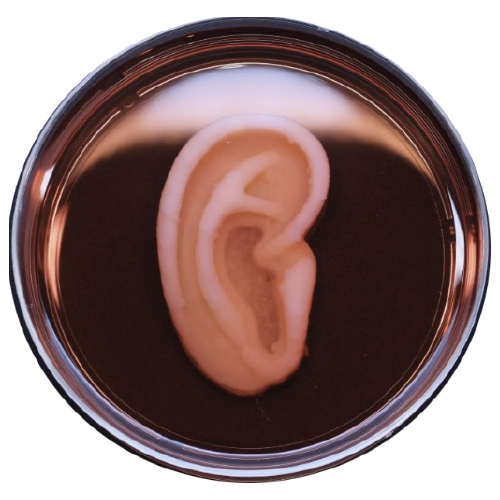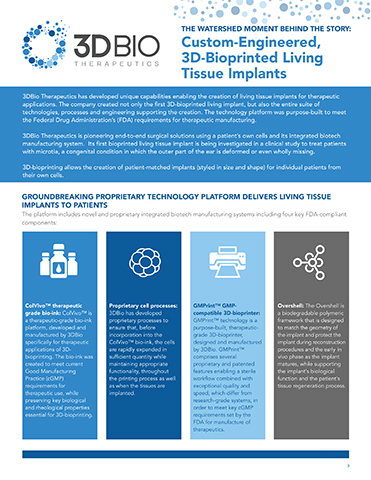Regenerative medicine company 3DBio Therapeutics and the Microtia-Congenital Ear Deformity Institute have successfully completed a human ear reconstruction using the former’s novel 3D printed AuriNovo living tissue implant for the first time.
The first-in-human Phase 1/2a clinical trial evaluated the safety and efficacy of AuriNovo for patients with microtia, a rare congenital deformity where one or both outer ears are absent or underdeveloped. 3DBio’s patient-specific living tissue implant was developed using 3D bioprinting technology to provide a viable treatment alternative to rib cartilage grafts and traditionally-used synthetic materials.
“As a physician who has treated thousands of children with microtia from across the country and around the world, I am inspired by what this technology may mean for microtia patients and their families,” said Arturo Bonilla, a leading pediatric ear reconstructive surgeon who performed the procedure. “This study will allow us to investigate the safety and aesthetic properties of this new procedure for ear reconstruction using the patient’s own cartilage cells.
“My hope is that AuriNovo will one day become the standard-of-care replacing the current surgical methods for ear reconstruction requiring the harvesting of rib cartilage or the use of porous polyethylene (PPE) implants.”

3DBio’s proprietary bioprinting technology
The 3D bioprinting field is seeing continual advances regarding the printing of functional tissues and implants, with the last few months alone seeing the development of bioprinted diabetes treatments, safer biodegrable breast implants, and alternatives to animal testing.
Bioprinting is also enabling the creation of more realistic and accurate anatomical models and surgical guides to aid the training, planning and outcomes of various medical procedures.
3DBio is a clinical-stage regenerative medicine firm aiming to solve medical challenges with its 3D bioprinted living tissue implants. The firm manufactures its implants via its suite of novel and proprietary bioprinting hardware and materials, including its GMPrint 3D bioprinter, ColVivo bioink, specialized cell culture system, and implantable protective Overshell technology.
AuriNovo is the firm’s first bioprinted product, a patient-specific, supportive living tissue implant designed for surgical reconstruction of the external ear in people born with microtia. Essentially, the implant is a collagen hydrogel scaffold encapsulating a patient’s own auricular cartilage cells that is bioprinted in the exact size and shape to match the patient’s opposite ear.
AuriNovo is currently being evaluated in a Phase 1/2a clinical trial for ear reconstruction in patients, having already been granted Orphan Drug and Rare Pediatric Disease designation by the US Food and Drug Administration (FDA). In fact, 3DBio’s entire proprietary 3D bioprinting platform has been specifically engineered to meet the FDA’s requirements for therapeutic manufacturing.

Trialing ear reconstruction in humans
According to the American Journal of Medical Genetics, Microtia affects around 1,500 babies born in the US every year. 3DBio’s AuriNovo implant has been designed to offer an alternative treatment for ear reconstruction to traditional methods, which include invasive cartilage grafts and synthetic replacements.
“The AuriNovo implant requires a less invasive surgical procedure than the use of rib cartilage for reconstruction,” said Bonilla. “We also expect it to result in a more flexible ear than reconstruction with a PPE implant. The AuriNovo living tissue implant is designed to provide a better solution for patients born with microtia by transforming their appearance and building their confidence and self-esteem.”
The implant is created by first 3D scanning a patient’s unaffected ear to specifically match the implant’s geometry, before the patient’s own auricular cartilage cells are incorporated into 3DBio’s ColVivo bioink. The full-size, living tissue implant is then 3D bioprinted using the firm’s GMPrint bioprinter in order to replace the patient’s microtia-affected ear.
“This is a truly historic moment for patients with microtia, and more broadly, for the regenerative medicine field as we are beginning to demonstrate the real-world application of next-generation tissue engineering technology,” said 3DBio CEO and Co-founder, Daniel Cohen. “It is the culmination of seven years of our company;s focused efforts to develop a uniquely differentiated technology platform meeting the FDA’s requirements for therapeutic manufacturing of reconstructive implants.”
The Phase 1/2a clinical trial is currently evaluating the safety and efficacy of the AuriNovo implant for use in reconstructive surgeries in humans. The trial will collect assess data that will be measured across a number of mediums, such as overall satisfaction scores from surgical outcomes and questionnaires.
The trial expects to enroll 11 patients and is being conducted in sites across Los Angeles, California, and Texas. The Texas site is home to the Microtia-Congenital Ear Deformity Institue, which has been helping children born with microtia and other ear deformities since 1996.
“We believe that the microtia clinical trial can provide us not only with robust evidence about the value of this innovative product and the positive impact it can have for microtia patients, but also demonstrate the potential for the technology to provide living tissue implants in other therapeutic areas in the future,” Cohen added.
With its first bioprinted implant having completed its first successful reconstructive surgery during the first-in-human clinical trials, 3DBio is looking to widen the scope of its proprietary 3D bioprinting technologies.
“Our initial indications focus on cartilage in the reconstructive and orthopedic fields including treating complex nasal defects and spinal degeneration,” said Cohen.
“We look forward to leveraging our platform to solve other high impact, unmet medical needs like lumpectomy reconstruction and eventually expand to other organs.”
Subscribe to the 3D Printing Industry newsletter for the latest news in additive manufacturing. You can also stay connected by following us on Twitter and liking us on Facebook.
Looking for a career in additive manufacturing? Visit 3D Printing Jobs for a selection of roles in the industry.
Subscribe to our YouTube channel for the latest 3D printing video shorts, reviews, and webinar replays.
Featured image shows a 3D printed AuriNovo “living” ear for reconstruction in Microtia patients. Photo via 3DBio Therapeutics.


